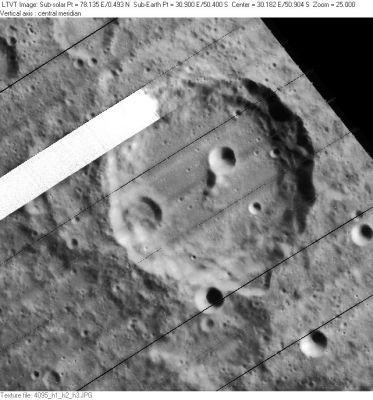Pitiscus
Contents
Pitiscus
|
Lat: 50.4°S, Long: 30.9°E, Diam: 82 km, Depth: 4.63 km, [/R%C3%BCkl%2075 Rükl 75], Nectarian |
Table of Contents

LO-IV-095H The sharp 10-km crater on the floor of Pitiscus (touching the central peak) is Pitiscus A. To its southwest (on the inner wall) is 13-km Pitiscus E. Still farther to the east, under the white blemish, is 24-km Pitiscus W. The 9-km bright-ray crater Pitiscus L is partially covered by the right margin. Due south of Pitiscus, the faint 43-km depression is [/Hommel Hommel] H with 8-km [/Hommel Hommel] HA at the position where its rim merges with Pitiscus. To the right of [/Hommel Hommel] H is 11-km [/Hommel Hommel] R. The only other IAU-named feature in this field is 25-km Pitiscus R, partially visible (to the left) along the top margin.
Images
LPOD Photo Gallery Lunar Orbiter Images Apollo Images
Maps
([/LAC%20zone LAC zone] 127B1) LAC map Geologic map
Description
Description: Elger
([/IAU%20Directions IAU Directions]) PITISCUS.--The most regular of the [/Vlacq Vlacq] group. It is situated on the N.W. of [/Hommel Hommel] (a curious oblong-shaped enclosure, Hommel h, with a very attenuated W. wall, and a large crater on a floor, standing at a higher level than that of Pitiscus, intervening). It is 52 miles in diameter, and is surrounded by an apparently continuous rampart, except on the W., where there is a crater, and on the S.E., where it abuts on Hommel h. Here there is a wide gap crossed by what has every appearance of being a "fault," resembling that in [/Phocylides Phocylides] on a smaller scale. There is a fine crater on the N. side of the interior connected with the S. wall by a bright ridge. Just beyond the W. border there is a shallow ring-plain of a very extraordinary shape.
Description: Wikipedia
Additional Information
- Depth data from [/Kurt%20Fisher%20crater%20depths Kurt Fisher database]
- Westfall, 2000: 4.63 km
- Viscardy, 1985: 3 km
- Cherrington, 1969: 3.1 km
- [/Central%20peak%20composition Central peak composition]: A, GNTA1 & GNTA2 ([/Tompkins%20%26%20Pieters%2C%201999 Tompkins & Pieters, 1999])
- Pitiscus and its satellite Pitiscus A and Pitiscus L are on the [/ALPO%20list%20of%20bright%20ray%20craters ALPO list of bright ray craters].
Nomenclature
Bartholemaeus; German mathematician (1561-1613).
- According to [/Whitaker Whitaker] (pp. 213-214), this name was introduced by [/Riccioli Riccioli], however the feature labeled with this name on Riccioli's map is what we now call [/Vlacq Vlacq], and the feature we now call Pitiscus (the present feature) was called Homelius (Riccioli's spelling of [/Hommel Hommel]). When, and by whom, the names were later rearranged is not entirely clear (from Whitaker's book). - JimMosher JimMosher
LPOD Articles
Bibliography
This page has been edited 1 times. The last modification was made by - tychocrater tychocrater on Jun 13, 2009 3:24 pm - afx3u2